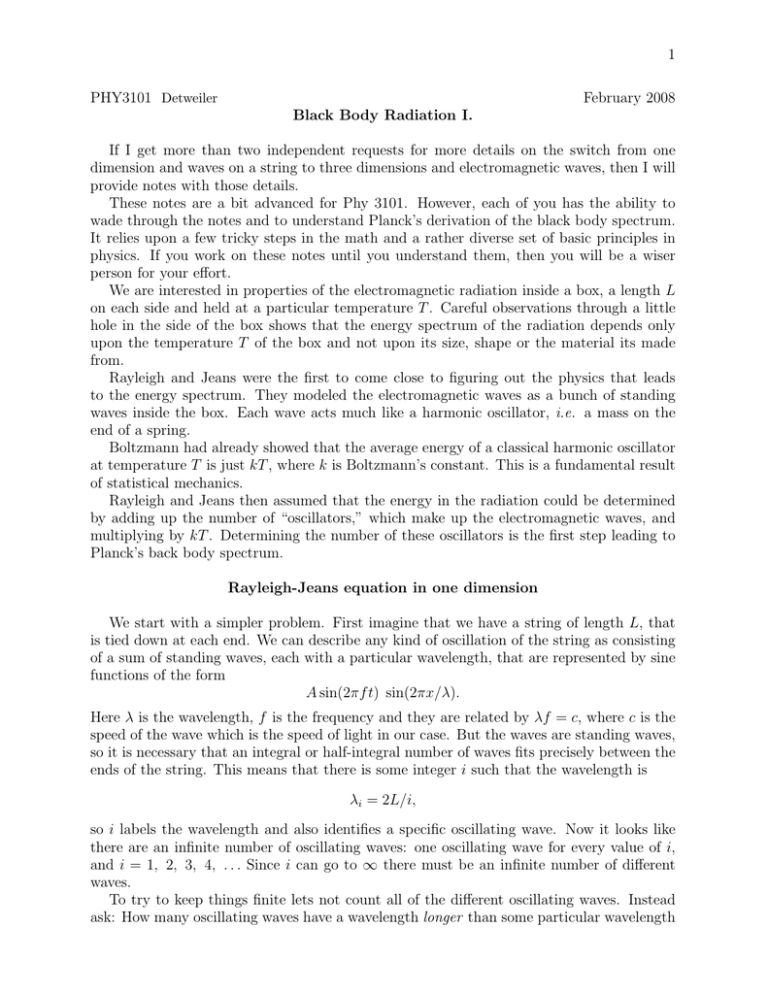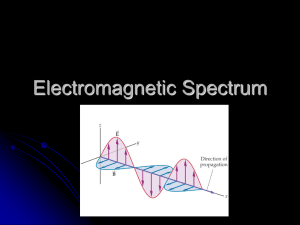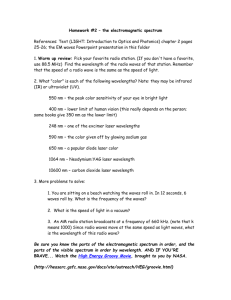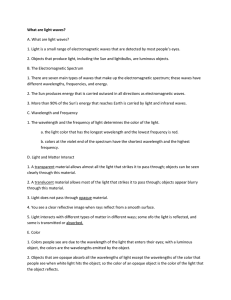1 PHY3101 February 2008 Black Body Radiation I.
advertisement

1 PHY3101 Detweiler February 2008 Black Body Radiation I. If I get more than two independent requests for more details on the switch from one dimension and waves on a string to three dimensions and electromagnetic waves, then I will provide notes with those details. These notes are a bit advanced for Phy 3101. However, each of you has the ability to wade through the notes and to understand Planck’s derivation of the black body spectrum. It relies upon a few tricky steps in the math and a rather diverse set of basic principles in physics. If you work on these notes until you understand them, then you will be a wiser person for your effort. We are interested in properties of the electromagnetic radiation inside a box, a length L on each side and held at a particular temperature T . Careful observations through a little hole in the side of the box shows that the energy spectrum of the radiation depends only upon the temperature T of the box and not upon its size, shape or the material its made from. Rayleigh and Jeans were the first to come close to figuring out the physics that leads to the energy spectrum. They modeled the electromagnetic waves as a bunch of standing waves inside the box. Each wave acts much like a harmonic oscillator, i.e. a mass on the end of a spring. Boltzmann had already showed that the average energy of a classical harmonic oscillator at temperature T is just kT , where k is Boltzmann’s constant. This is a fundamental result of statistical mechanics. Rayleigh and Jeans then assumed that the energy in the radiation could be determined by adding up the number of “oscillators,” which make up the electromagnetic waves, and multiplying by kT . Determining the number of these oscillators is the first step leading to Planck’s back body spectrum. Rayleigh-Jeans equation in one dimension We start with a simpler problem. First imagine that we have a string of length L, that is tied down at each end. We can describe any kind of oscillation of the string as consisting of a sum of standing waves, each with a particular wavelength, that are represented by sine functions of the form A sin(2πf t) sin(2πx/λ). Here λ is the wavelength, f is the frequency and they are related by λf = c, where c is the speed of the wave which is the speed of light in our case. But the waves are standing waves, so it is necessary that an integral or half-integral number of waves fits precisely between the ends of the string. This means that there is some integer i such that the wavelength is λi = 2L/i, so i labels the wavelength and also identifies a specific oscillating wave. Now it looks like there are an infinite number of oscillating waves: one oscillating wave for every value of i, and i = 1, 2, 3, 4, . . . Since i can go to ∞ there must be an infinite number of different waves. To try to keep things finite lets not count all of the different oscillating waves. Instead ask: How many oscillating waves have a wavelength longer than some particular wavelength 2 λ0 ? If i is too large then λi will be smaller than λ0 . We are requiring that λi = 2L/i ≥ λ0 ⇒ i ≤ 2L/λ0 . And the very greatest that i can be is imax = 2L/λ0 . For convenience we drop the subscript 0 and just say: The number of oscillating waves on a string which have a wavelength greater that λ is imax = 2L/λ. A more interesting result is the number is the number of oscillating waves per unit length of the string, which is just imax /L or N (λ) ≡ imax /L = 2/λ. It is also useful to know how many oscillating waves have a wavelength greater than λ and a bit less than λ + ∆λ for some small ∆λ and per unit length of the string. The answer is ∆λ times a function of λ, and we will call this function n(λ). We find n(λ) by taking a derivative and the result is n(λ) ∆λ = − 2 1 dN (λ) ∆λ = 2 ∆λ L dλ λ ⇒ n(λ) = 2 . λ2 The minus sign might look odd, but there are more wavelength’s greater than λ than there are greater than λ + ∆λ, and the difference is as given above. This result for n(λ) might be called the Rayleigh-Jeans equation in one dimension. Now answer the question: “If the string is at temperature T , how much energy, per unit length, is there in all of the oscillating waves whose wavelength is greater than λ?” There are N (λ) different oscillating waves, and each of these has average energy kT . So the total energy is N (λ) × kT = 2kT /λ. We can describe this as the energy density of the waves with wavelength less than λ, which defines U (λ) = N (λ) × kT = 2kT /λ. A more interesting question we might ask is “What is the energy density for wavelengths between λ and λ + ∆λ, where ∆λ is small?” We call the answer to this question u(λ) and we obtain this quantity by taking the derivative of the energy density U (λ), u(λ) ∆λ = − dU ∆Λ = 2kT /λ2 ∆Λ dλ ⇒ u(λ) = n(λ) kT = 2kT /λ2 . The function u(λ) is also called the energy spectrum, and be sure to note that it depends upon the temperature T of the string. The units of u(λ) might be eV/ m nm, so to get an energy out of this you need to multiply by the length of the string, and by the range of wavelengths ∆λ, which might have a unit of nm. Here is a summary of the important results of this section: For a one dimensional string, the spectrum of the number density of oscillating waves is n(λ) = 2 , λ2 3 and its units might be a number/( m· nm). So to get the actual number of oscillating waves for a string of length L and for a range of wavelengths centered at λ and with a width ∆λ you need to calculate 2L∆λ n(λ) × L × ∆λ = . λ2 Similarly, for a one dimensional string at temperature T , the spectrum of the energy density of oscillating waves is 2kT u(λ) = 2 , λ and its units are J/( m· nm). So to get the actual energy for a string of length L and for a range of wavelengths centered at λ and with a width ∆λ you need to calculate u(λ) × L × ∆λ = 2kT L∆λ . λ2 If electromagnetic waves traveled in only one dimension then this last result would be called the the Rayleigh-Jeans formula. Rayleigh-Jeans equation in three dimensions In my own notes I have a derivation of the same sort of problem in three dimensions but with the string replaced by electromagnetic waves. This results in the Rayleigh-Jeans equation. There are two substantial complications. First, we need to deal with Maxwell’s equations which involve electric and magnetic fields and we need to set up proper boundary conditions on the walls of the cavity. The second is changing to three dimensions rather than the one dimension in the example that we just did. The result is that the number of modes of oscillation of an electromagnetic field, per unit volume, with a wavelength greater than λ is 8π N (λ) = 3 . 3λ The change to Maxwell’s equations provides an extra factor of 2, while considering three dimensions changes the 2/λ in the one dimensional problem for N (λ) to 4π/3λ3 . It follows that for an electromagnetic field the spectrum of the number density of modes of oscillation is dN (λ) 8π n(λ) = − = 4. dλ λ 3 and its units might be a number/( m · nm). So to get the actual number of modes of oscillation for a cavity of length L on a side and for a range of wavelengths centered at λ and with a width ∆λ you need to calculate n(λ) × L3 × ∆λ = 8π 3 L ∆λ. λ4 The Rayleigh-Jeans energy spectrum has kT ’s worth on energy in each mode, and we end up with an energy spectrum 8πkT u(λ) = λ4 4 for a given temperature T . Note that this spectrum would imply an infinite amount of energy, because Z ∞ 8πkT U= dλ λ4 0 is infinite. While this can’t possibly agree with Nature, based upon pre-1900 physics there is no error in the derivation. Planck had to stir things up a bit in order to get a result that agrees with Nature.





